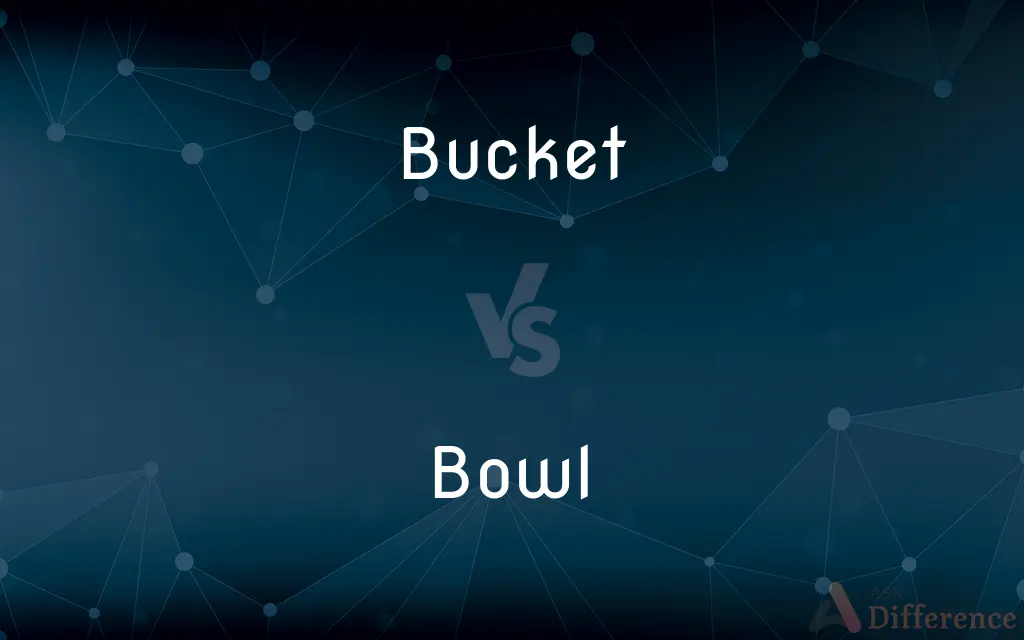Bucket vs. Bowl — What's the Difference?
Edited by Tayyaba Rehman — By Fiza Rafique — Updated on March 1, 2024
A bucket is a cylindrical container with a handle for carrying liquids, while a bowl is a round dish for holding food or liquids, without a handle.

Difference Between Bucket and Bowl
Table of Contents
ADVERTISEMENT
Key Differences
Buckets are typically larger, cylindrical containers made of plastic, metal, or wood, designed primarily for carrying liquids. They often come with a handle to facilitate easy transport. Bowls, in contrast, are open-top containers but are usually smaller and crafted specifically for holding food or liquids. They are essential kitchen and dining utensils, made from materials such as ceramic, glass, or plastic.
A bucket's primary function revolves around tasks like cleaning, carrying water, or mixing substances. Bowls do not have handles and are used for eating, serving, or mixing ingredients.
The design of a bucket, with its sturdy handle and often a spout for pouring, makes it suitable for heavier-duty tasks and carrying larger volumes of liquids. This design reflects its utilitarian purposes in various settings, including construction and gardening.
Bowls are shaped to facilitate easy access for eating or mixing, with a design that accommodates utensils like spoons or mixers. Their wide opening and depth make them ideal for containing meals or ingredients during food preparation.
Buckets are valued for their durability and functionality in more demanding tasks, bowls are appreciated for their role in food presentation and preparation. The choice between a bucket and a bowl depends on the task at hand: carrying and pouring liquids or serving and preparing food.
ADVERTISEMENT
Comparison Chart
Primary Use
Carrying liquids
Holding food or liquids
Material
Plastic, metal, wood
Ceramic, glass, plastic
Handle
Yes
No
Shape
Cylindrical
Rounded
Functionality
Heavy-duty tasks, transport
Eating, serving, mixing
Compare with Definitions
Bucket
Can be made of various materials for different uses.
The wooden bucket was used for collecting sap.
Bowl
Lacks a handle, designed for table use.
The salad looked inviting in the glass bowl on the table.
Bucket
Used for heavy-duty tasks like construction.
He carried a bucket of cement to the work site.
Bowl
Varied in material based on use.
The chef preferred a metal bowl for mixing ingredients.
Bucket
Larger and more durable than bowls.
They used a sturdy plastic bucket to carry the beach toys.
Bowl
Smaller and used in dining and cooking.
She grabbed a small bowl to mix the dressing.
Bucket
Often features a spout for pouring.
He used the bucket's spout to pour water into the narrow container.
Bowl
Essential for food presentation.
He garnished the dish before placing it in the serving bowl.
Bucket
A unit of dry measure in the US Customary System equal to 2 pecks (17.6 liters).
Bowl
A bowl is a round dish or container typically used to prepare and serve food. The interior of a bowl is characteristically shaped like a spherical cap, with the edges and the bottom forming a seamless curve.
Bucket
A container with a handle for carrying liquids.
She filled the bucket with water to mop the floor.
Bowl
A round, deep dish or basin used for food or liquid
A mixing bowl
A sugar bowl
Bucket
A bucket is typically a watertight, vertical cylinder or truncated cone or square, with an open top and a flat bottom, attached to a semicircular carrying handle called the bail.A bucket is usually an open-top container. In contrast, a pail can have a top or lid and is a shipping container.
Bowl
A stadium for sporting or musical events
The Hollywood Bowl
Bucket
A cylindrical vessel used for holding or carrying liquids or solids; a pail.
Bowl
A bowl-shaped stadium or outdoor theater.
Bucket
The amount that a bucket can hold
One bucket of paint will be enough for the ceiling.
Bowl
A roll or throw of a ball in lawn bowling and other bowling games.
Bucket
A receptacle on various machines, such as the scoop of a power shovel or the compartments on a water wheel, used to gather and convey material.
Bowl
Bowls(used with a sing. verb) See lawn bowling.
Bucket
To draw or lift in, or as if in, buckets; as, to bucket water.
Bowl
A dish that is round and open at the top for serving foods
Bucket
To pour over from a bucket; to drench.
Bowl
A large structure for open-air sports or entertainments
Bucket
To make, or cause to make (the recovery), with a certain hurried or unskillful forward swing of the body.
Bowl
A wooden ball (with flattened sides) used in the game of bowls
Bucket
A roughly cylindrical that is vessel open at the top
Bowl
A small round container that is open at the top for holding tobacco
Bucket
The quantity contained in a bucket
Bowl
A round dish for eating or preparing food.
She served the soup in a deep ceramic bowl.
Common Curiosities
Why do buckets have handles but bowls do not?
Buckets have handles for easy transport of liquids, while bowls are designed for stationary use, such as eating or serving.
Can buckets and bowls be made of the same materials?
Yes, both can be made from materials like plastic, but buckets are also commonly made of metal or wood, whereas bowls are often ceramic or glass.
What is the primary difference between a bucket and a bowl?
The primary difference is their use; buckets are for carrying liquids with a handle, while bowls are for holding food or liquids without a handle.
Can a bowl be used for tasks typically reserved for buckets?
While bowls can hold liquids, they are not designed for heavy-duty tasks or transporting materials like buckets are.
Are buckets always larger than bowls?
Typically, yes, buckets are larger to carry significant amounts of liquids, but there can be small buckets and large bowls.
Why might someone choose a bucket over a bowl for carrying water?
Due to its handle and larger volume, a bucket is more practical for carrying larger quantities of water.
Is the material of a bucket or bowl important for its function?
Yes, the material affects the container's durability, heat resistance, and suitability for specific tasks or foods.
How do the shapes of buckets and bowls differ in terms of functionality?
Buckets have a cylindrical shape for stability and volume, while bowls have a rounded shape for easy access and mixing.
Can both buckets and bowls be used in food preparation?
Bowls are primarily used in food preparation for mixing or serving, while buckets are not typically used in cooking.
Why might a bowl be preferred for serving food over a bucket?
Bowls are designed for table use, offering an aesthetically pleasing way to present and serve food.
Can the design of a bowl affect its use?
Yes, the depth, shape, and size of a bowl can determine its suitability for different foods or preparation methods.
Are there any specific tasks for which a bucket is uniquely suited?
Yes, tasks like carrying large volumes of liquid, mixing cement, or collecting garden waste are suited for buckets.
What are some common materials for bowls and their benefits?
Ceramic bowls retain heat well, glass bowls are non-reactive and good for serving, and plastic bowls are lightweight and versatile.
How does the presence of a handle on a bucket enhance its functionality?
The handle allows for easy lifting and transporting of the container, especially when filled with liquid.
Is there a cultural significance to the use of bowls in dining?
Yes, in many cultures, bowls are central to dining traditions, used for staple dishes like soups, rice, and noodles.
Share Your Discovery

Previous Comparison
Cubism vs. Surrealism
Next Comparison
Detainment vs. DetentionAuthor Spotlight
Written by
Fiza RafiqueFiza Rafique is a skilled content writer at AskDifference.com, where she meticulously refines and enhances written pieces. Drawing from her vast editorial expertise, Fiza ensures clarity, accuracy, and precision in every article. Passionate about language, she continually seeks to elevate the quality of content for readers worldwide.
Edited by
Tayyaba RehmanTayyaba Rehman is a distinguished writer, currently serving as a primary contributor to askdifference.com. As a researcher in semantics and etymology, Tayyaba's passion for the complexity of languages and their distinctions has found a perfect home on the platform. Tayyaba delves into the intricacies of language, distinguishing between commonly confused words and phrases, thereby providing clarity for readers worldwide.
















































